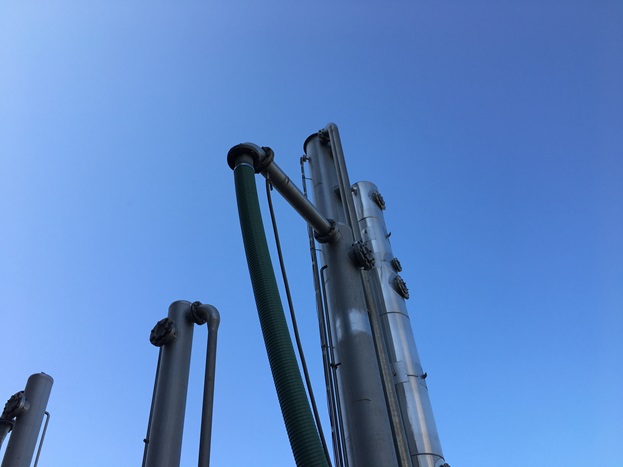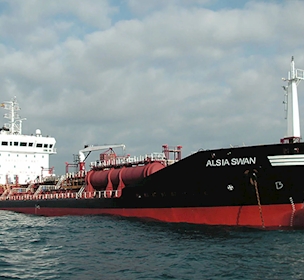Documenting efficient carbon capture at Ammongas
Carbon capture is an important measure in the battle against climate change. Ammongas has received key documentation confirming the quality of their carbon capture system for co-generation plants.
Danish environmental law has set a target of reducing CO2 emissions by 70% by 2030 relative to 1990 levels. Carbon capture and storage is a key technology for achieving this goal.
For instance, CO2 can be collected from the exhaust gas generated by combustion processes. Then, the collected CO2 can either be stored underground or used as "raw material" for industry, such as in the production of new fuels.
From biogas to co-generation plants
Ammongas is a company that specialises in air and gas purification, with an emphasis on carbon capture. With many years of carbon capture experience in biogas facilities, the company is preparing to expand its activities to include carbon capture from exhaust gases at co-generation plants. The two processes are alike in many ways.
After collaborating with FORCE Technology, Ammongas now has documentation to show that their system not only efficiently captures CO2, but also that it does not release problematic substances like nitrosamines and nitramines at concentrations that would be cause for concern.
Absorbing and concentrating CO2
The capture of CO2 from, for example, a co-generation plant involves a technology known as chemical absorption. The carbon capture system "washes" the exhaust gas with a solvent containing substances called amines.
The amine-based solvent can bind CO2, so the result of the process is cleaned gas with minimal CO2 content. The cleaned gas can be released into the atmosphere, while the concentrated CO2 generated in the process can be stored or used for another purpose.
Read more about carbon capture here
Collaborating on testing and documentation of a pilot facility for carbon capture
FORCE Technology originally contacted Ammongas in connection with the CO2 Hub Hanstholm project (see box to the right). FORCE Technology was searching for a pilot facility for carbon capture that would be suitable for taking chemical and gas measurements. Ammongas was able to supply such a facility.
Given that Ammongas needed a way to demonstrate the quality of its system to prospective customers and regulatory agencies, the company decided to collaborate with FORCE Technology on testing and documentation for its pilot facility.
Broadly speaking, Ammongas wanted figures to quantify the efficiency of its system in capturing CO2, as well as proof that the facility does not release significant quantities of potentially problematic substances, including nitrosamines and nitramines. These substances are breakdown products from the amine-based solvent that binds CO2. Nitrosamines are of particular concern because they are suspected carcinogens.

From detailed measurements to a thorough report
FORCE Technology spent a day and a half taking detailed measurements from Ammongas's facility. Specialists measured the released quantities of problematic substances and combustion-related gas components that quantify the facility's efficiency. The finished product was an accredited report.All the figures were great. Now, we can use this report to tell our customers that our system works as intended: We can capture a large percentage of the CO2, and the concentration of the undesirable substances is so low that they pose no problem.Alexander Jensen / Ammongas
"All the figures were great. Now, we can use this report to tell our customers that our system works as intended: We can capture a large percentage of the CO2, and the concentration of the undesirable substances is so low that they pose no problem. Naturally, it's also important that we had an accredited, impartial company take the measurements, as opposed to taking them ourselves," says Alexander Jensen at Ammongas.
"The report contains a lot of measurements that give us deeper insight into the gas composition in our system. The report is also very thorough, including tables, images, illustrations, and explanations of the methodology used."
Live measurements offer better gas composition data
Ammongas is interested in continuing its collaboration with FORCE Technology and taking additional measurements from its system.
"You invest a lot in staying on top of the latest technology. For example, I heard that you recently purchased a PTR-ToF-MS: a mass spectrometer with time-of-flight measurement. That instrument would allow us to see what happens as the gas composition changes in real-time. We don't want to just look at, say, an average taken over two hours, the way we do today," Jensen says.
From carbon capture to storage
Ammongas is pulling out all the stops to become a key player in carbon capture—and fighting climate change in the process. Being able to concentrate CO2 and separate it from exhaust gases is a major first step. However, realising the benefit to the climate also requires a good solution for transporting and storing CO2. Ammongas is working on this now.
"Specifically, we want to make the CO2 liquid so it'll be easier to transport. Then, we can take it out on the North Sea in a storage unit and pump it under the ground," Jensen explains.
Contributing to a greener transportation sector
The captured CO2 can also produce e-methanol, which can be used as a fuel additive to make the transportation sector greener. This will be the case at the Kassø facility, currently being built by Ammongas's parent company, European Energy. The facility is expected to begin operating in 2024–2025.
In other words, there is a lot of potential there. For now, Ammongas and its stakeholders can content themselves with documentation proving that the company is able to offer an efficient carbon capture system that does not release amines and other potentially problematic breakdown products.





